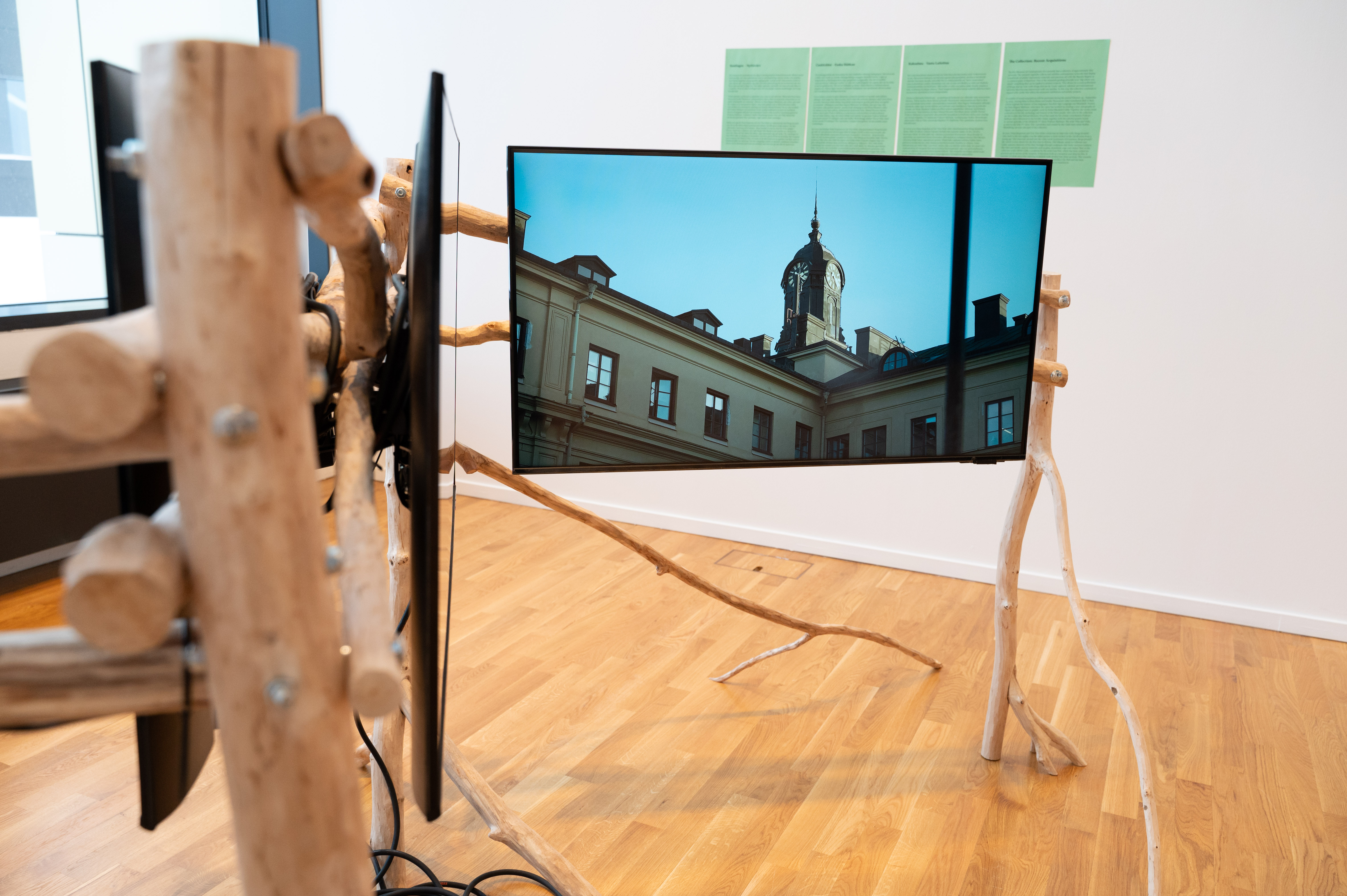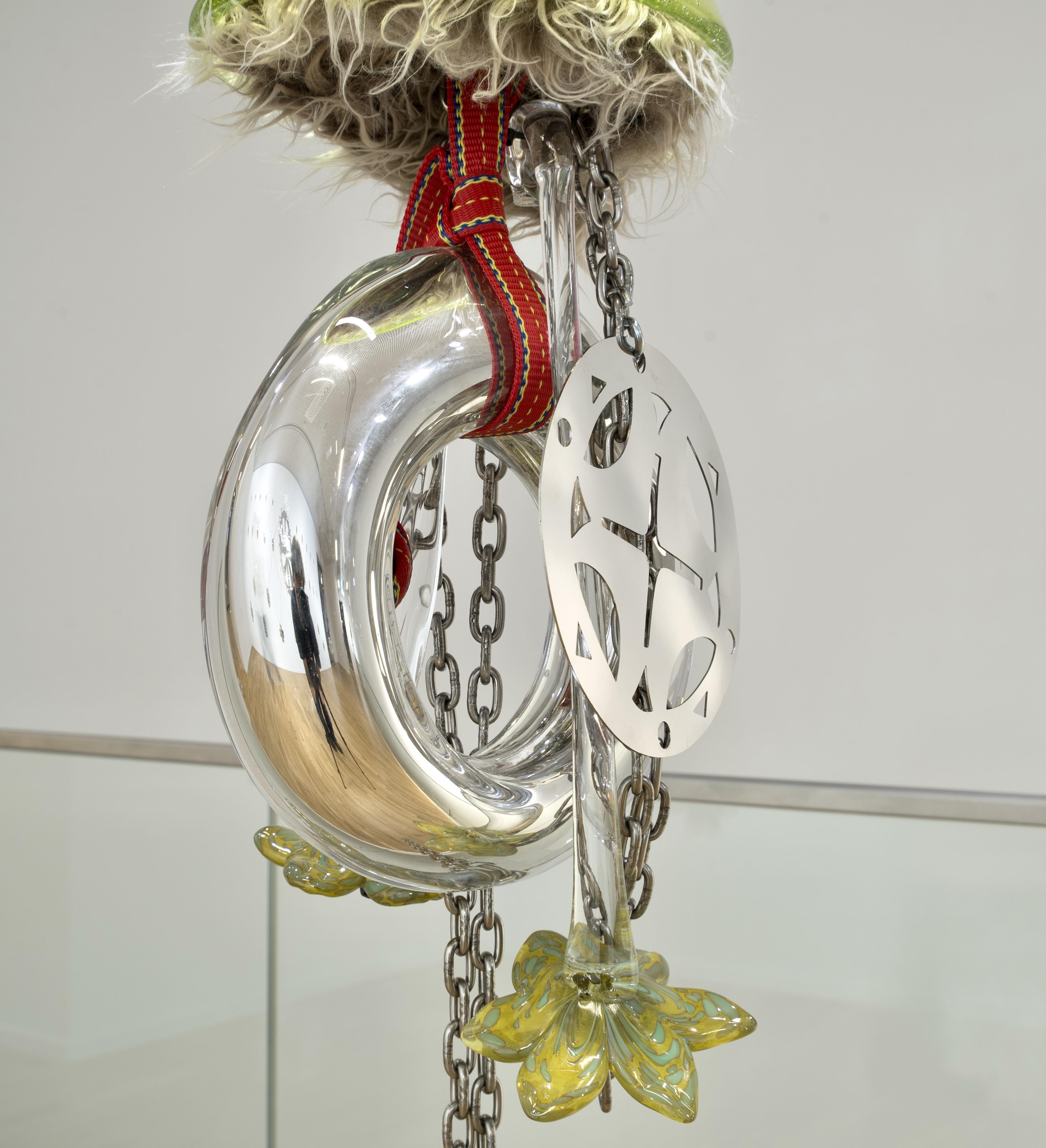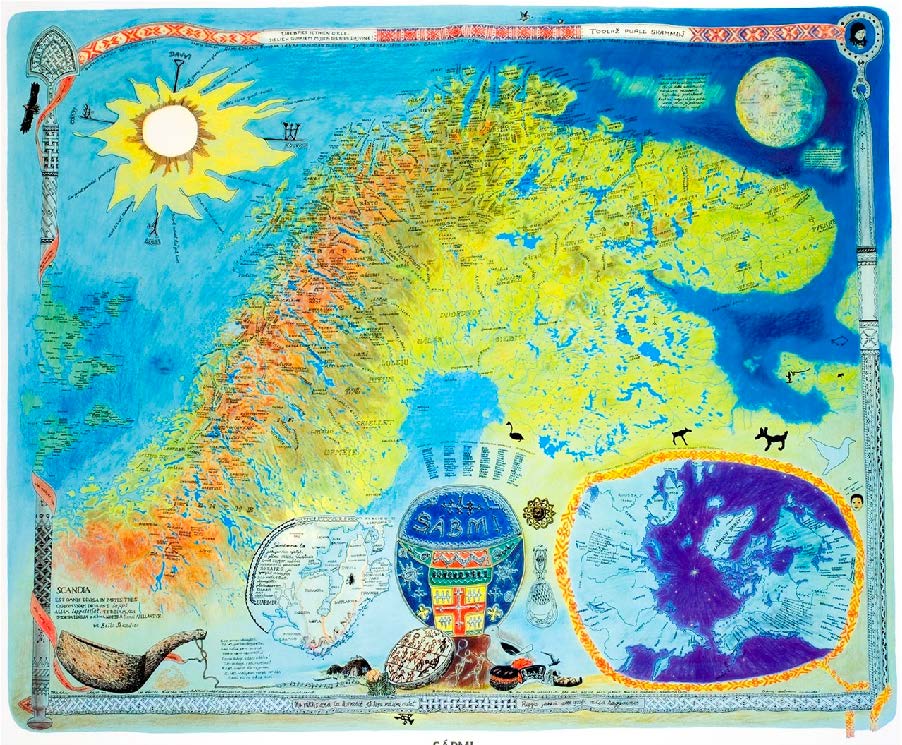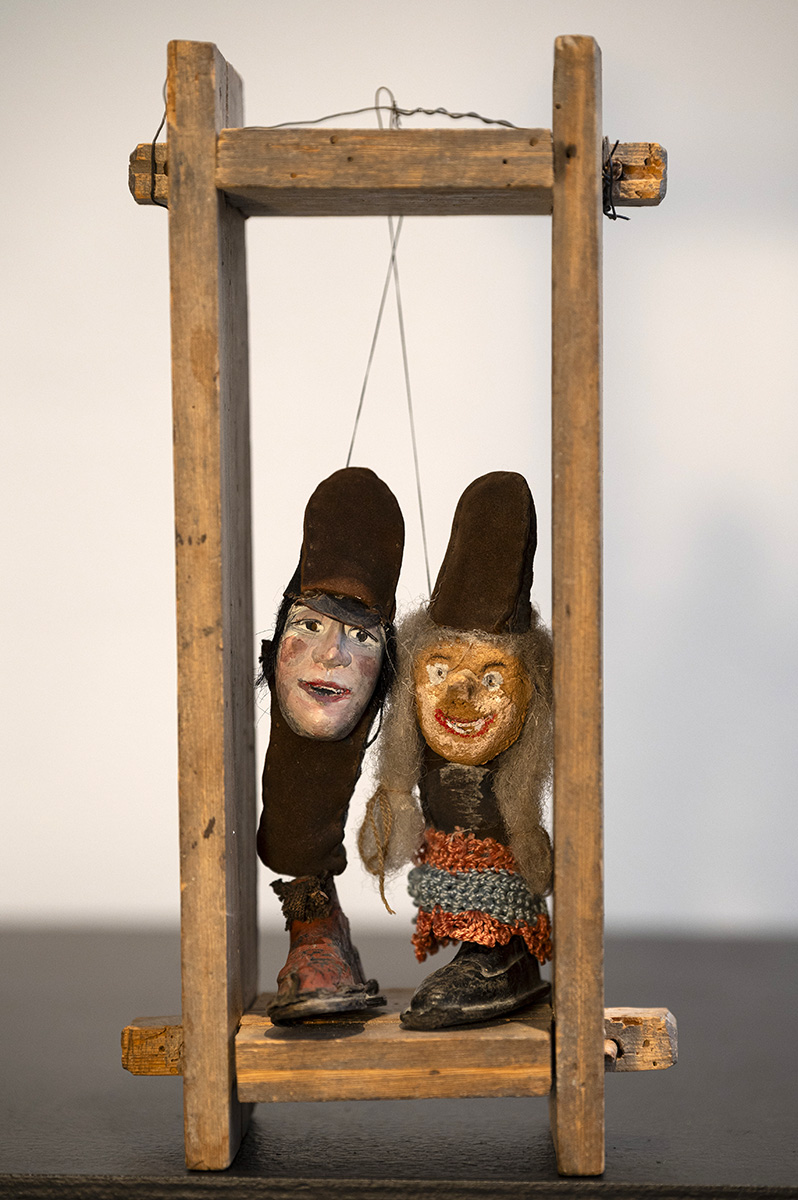The Collection 1
15 February 2024—31 August 2025
Exhibitions
4th floor, Kristallen
The Kin Museum of Contemporary Art currently has a collection of approximately fifty artworks. The museum regularly collects and exhibits contemporary artworks that display a multitude of artistic expressions, materials, and practices, all with the Barents Region as a common point of departure. One of the museum’s guiding principle is to “dig where you stand,” something that can be applied to several contexts. This allows for a cross-pollination of things that are near with things that are far. Local, regional, national, and international activities thus become intertwined with one another. In this way, the collection continues to expand with works that reflect the museum’s exhibitions and artistic projects.
A number of recent acquisitions will be presented during the period February 15 – September 15, 2024. Among them is Karin Keisu and Josefin Thuresson’s video installation Back to Back, which explores the history of two languages: Swedish Sign Language and Meänkieli. Posters by Hans Ragnar Mathisen, who since the 1970s has worked on creating a new cartography of Sápmi, are displayed next to graphic work by Britta Marakatt-Labba. Together, the works create a narrative of the life, mythology, and history of the Sámi people. Also new to the collection are the models that Behzad Khosravi Noori has made for his artistic contribution Professor Balthazar and a Monument to the Invisible Citizen, together with the colorful posters found in various episodes of the children’s TV show Professor Balthazar. The dolls Vilse and Vilda, as seen in the kids TV show Vilse i pannkakan and created by the Luleå-born artist Staffan Westerberg, are now also part of the collection.
In 2012, Sössa Jörgensen and Geir Tore Holm conducted an interview with Bengt Jernelöf, who, back in the late aughts, was the oldest person to have worked in the LKAB mine from a young age. This interview turned into the video work Luossavaara-Kiirunavaara: Bengt Jernelöf’s life, which is now shown for the first time in Kiruna. Olof Marsja, raised in Gällivare and Luleå, captures elements of his Sámi heritage through sculptures that freely interpret artefacts like belts and needle cases in materials such as glass, aluminum, rope, and chains. New to the collection is also Mobile Lobby, a sculpture by the artist Luca Frei, which has been created for practical use in service of the museum. It functions both as a reception and shop for Kin. It consists of a desk and a free-standing bookshelf, both divided into three sections. This versatile piece of furniture has been placed in the atrium of the Kristallen City Hall and has been designed with mobility in mind, its wheels making it easy to manoeuvre.
Behzad Khosravi Noori
Professor Balthazar and a Monument to the Invisible Citizen
Three playground models and eleven posters, 2018–2023
In the eponymously titled television series, the friendly Professor Balthazar solves all kinds of social and philosophical problems with the help of his imagination, his determination, and a magic machine. Produced by Zagreb Film Company between the years 1967 and 1978, this colorful animation series has been seen by millions of children and adults in neutral countries and those associated with the Non-Aligned Movement, chiefly among them Yugoslavia. Behzad Khosravi Noori’s piece is based on an episode about the invisible citizen Martin, who is ignored by everyone in Balthazargrad and therefore decides to move away. Upon his departure, the other citizens begin to miss him, although they only vaguely remember who he was. Overcome with guilt, they create a monument to “the invisible citizen.” The artist has interpreted this as a pink and yellow climbing frame for children. The models here are of three climbing frames created by the artist, which can be found in Zagreb, Asbest, and Moscow respectively. A fourth climbing frame was exhibited at the Kristallen City Hall in Kiruna in 2023, as a part of the exhibition “The TV Trampoline: From Children’s Television to Contemporary Art and Literature.” It now stands permanently at the Sámi School in Kiruna.
In this, one might notice that the the posters seen throughout are recreations from those that appear in the different episodes of Professor Balthazar. By removing them from their original context and placing them on real-life walls, the artist has blurred the lines between Professor Balthazar’s world and ours.
Behzad Khosravi Noori was born and raised in Tehran and now lives in Sweden. His research-based artistry centers around stories from the Global South and the cultural relations that existed as a counternarrative to the Cold War’s dichotomy between East and West, for instance within the Non-Aligned Movement.
Lena Stenberg
Nomad–The Colour of Colonialism
Graphic print, 2020
Color of Colonialism by Lena Stenberg reflects on historical and cultural narratives tied to colonialism in Scandinavia. By juxtaposing graphic imagery from Norway, Sweden, and Finland, each paired with their respective national flags, Stenberg highlights aspects of the shared yet distinct histories in relation to the Sámi people, the Indigenous inhabitants of Sápmi. The compositions feature archival photographs of Sámi individuals and communities layered with national symbols, drawing attention to the complex and often contentious relationship between Indigenous and national identities. Through this work, Stenberg brings forward the histories of colonisation, cultural assimilation policies, and the resilience of the Sámi culture.
Lena Stenberg is a Sámi artist based in Kiruna, and is known for addressing themes of identity, history, and the effects of colonialism through multimedia installations and graphic materialities. Her works often encourage dialogue about the socio-political history of the Sámi and the ongoing cultural implications of colonial frameworks.
Hans Ragnar Mathisen
Sámisat 01.07.90
Poster, 1990
Návuonna & Lahppi
Poster1998-1999
Ditvtasvuodna / Tysfjord
Poster, 1985
Sábmi 1975
Poster, 1975
Davviálbmogat
Poster, 1989
Finnmärku fylka / Finnmark County
Poster, 1992
Hans Ragnar Mathisen’s maps of the Baltic Shield shine a light on knowledge and experiences that have been suppressed. Hand-drawn, painted, and then printed in large editions as posters, they provide an overview of Sápmi and an insight into different parts of the region. The maps are rich in detail, incorporating images of traditional drinking cups, drums, animals, symbols, and Sámi clothing. What drew the most attention when he presented the maps for the first time in 1975 was that the names of places had been written in the form of Sámi that was spoken in the specific locations. As an artist, Mathisen was part of a group that was at the forefront of the fight for decent living conditions for the Sámi people, during a wave of reclaimed Sámi pride and self-awareness. The approximately fifty maps provide a fascinating account of indigenous peoples’ specialized geographical and biological knowledge and a norm-critical perspective of a world liberated from national borders. The maps have been created by tracing maps from atlases and filling these with watercolor to create something that can be described as flattened, colorful encyclopedias that include both words and images.
Hans Ragnar Mathisen was born in Narvik in 1945 and today works in Tromsø. He studied painting at the Norwegian National Academy of Craft and Art Industry in Oslo and painting and graphic design at the National Academy of Fine Arts in Oslo. His first solo exhibition was in 1975 at the Nordic-Sámi Institute in Kautokeino. In 1978 he settled in Máze in Finnmark County with seven young colleagues, who together founded the Sámi Artist Group, a forerunner to the Sámi Artist Association (Sámisk Kunstnerforbund), established in 1979. As an author, he has written among other things the play Ikke ingenting: et teaterstøkke i tre akte from 1983. Hans Ragnar Mathisen took part in Documenta 14 in Athens and Kassel in 2017.
Karin Keisu & Josefine Thuresson
Back to Back, 2021
Video installation
The video installation Back to Back investigates experiences connected to language, education, and the Swedish nation state’s normative conceptualization of the ideal citizen. What the languages Swedish Sign Language and Meänkieli have in common is that they, back in the day, were not considered necessary for the development of “modern Sweden.” Within the education system Sign language was forbidden in 1880 and deaf students were required to read lips and attend speech therapy. Evident then in workers’ homes in Norrbotten County, where less well-to-do children were educated between the years 1903–1954, speaking Meänkieli was forbidden. The ban was a part of the Swedish state’s “Swedeification” agenda, which aimed to shape the citizens of the future. Craft and handiwork courses were included in the education systems for both groups, so that they would become moral, productive citizens. To contrast this way of thinking about creativity, the artists have placed their videos in an unruly wooden installation, its sculptural body referring to playfulness, intuition, and multilingualism.
Karin Keisu, born in Tornedalen in 1995, and Josse Thuresson, born in Stockholm in 1992, have been working together since 2018. They work with film, performance, text, new media, and curation, with a focus on the politics of language, queer temporality and agency from within the margins. They have studied at Konstfack, Oslo National Academy of the Arts, and the Academy of Fine Arts, Vienna.
Luca Frei
Mobile lobby, 2024
Lasered plywood and lacquered MDF, castor wheels
Mobile lobby is a sculpture by the artist Luca Frei, built for pragmatic use. It functions as a reception for Kin and consists of a desk and a free-standing bookshelf, both divided into three sections. This multifaceted piece of furniture is placed in the atrium of the Kristallen City Hall and has been created with mobility in mind, its wheels making it easy to manoeuvre. The emerald green color of the work makes its presence both striking and visually coherent within the space. During the museum’s opening hours, the sculpture is used as a welcoming hub and an information center. Books about art and culture will be for sale here. The integration of four stools and a table on trestles further strengthens this function. Mobile lobby has been created by Luleå Design and Specialty Woodwork and is now a part of the museum’s collection.
Luca Frei grew up in Lugano and has lived in Malmö since the beginning of the 2000s. In his practice he unites sculpture, installation, textiles, exhibition design, and book design in works that tend to have a practical purpose. He is interested in collective processes and pedagogy, often using historical references as well as themes from daily life in his work.
Olof Marsja
Taking inspiration from, for example, traditional Sámi belts, Olof Marsja plays and experiments with a kind of false historicity. This is an “unfinished” aesthetic, where the different components of the work go beyond established aesthetic forms and traditions. This is true of the hanging sculpture XXX, which makes reference to the small traditional Sámi needle cases made of reindeer horns. For hundreds of years, the practice of creating these has been well-established within duodji, the tradition of Sámi crafts. Olof wishes to circumvent the concept of essentialism that is so often applied to minorities, partly by relating and combining parts of his Sámi heritage with contemporary 3D-software aesthetics, and duodji with synthetic materials. Carefully carved wood, cast metal, hand-blown glass, together with found and roughly reworked objects, all come together in unexpected combinations.
Olof Marsja, born in Gällivare in 1986, lives and works in Göteborg and was educated at Konstfack. In his sculptural artworks, hand-made, organic and industrially produced materials merge to create ambiguous figures and objects.
Staffan Westerberg
Vilse and Vilja
Dolls made for the children’s TV show Vilse i pannkakan, 1975
In Staffan Westerberg’s Vilse i pannkakan, a widely debated children’s TV show with a cult following in Sweden, features the main character Vilse together with his Vilja. At the dinner table, Vilse is refusing to finish his pancake, despite his parents’ insistence. Instead, he begins to imagine what might be going on inside the pancake. With the help of hand-made dolls and a pancake the size of a table, Vilse leads the viewer into a landscape that is as terrifying as it is whimsical. It is a multi-faceted and surrealistic world where traumatic memories, life stories, food, dreams, and fantasies all unfold. This is a world that does not shy from things that are scary or fantastic.
Staffan Westerberg was born in 1934 and grew up in Luleå. Using simple materials, he began setting up plays early in his career, often for children. Eventually he moved to Stockholm where he established a name for himself in the world of theatre, and during the 1960s he became a recurring figure on Swedish television. He has contributed greatly to arts and culture in Sweden as an actor, director, scriptwriter, author, and visual artist.
Søssa Jörgensen & Geir Tore Holm
Luossavaara-Kiirunavaara: Bengt Jernelöfs liv
(Luossavaara-Kiirunavaara: Bengt Jernelöf’s Life), 2012
Video 23:30 min
This video work consists of two scenes: one showing an older man sitting in a leather armchair at home, talking about his life in Kiruna and Laxforsen, and another showing a landscape filmed from a distance. The scenes are bound together by beautiful, melancholic violin music where Sámi musical progressions are played as traditional Norwegian folk music. The artist duo Geir Tore Holm and Søssa Jørgensen wished to get closer to those who had given their entire working lives to LKAB. The Swedish Tax Agency helped them get in touch with the mining company’s oldest former worker, Bengt, who became an errand-boy already in the 1940s. The presence of Sámi people and culture is not mentioned once by the old miner, however, even though they have spent a whole life on the same land. The short meeting with Bengt provides a dizzying insight into the mine’s enormously significant impact on so many people’s lives, its global connections, countered with the stories that are heard only as faint melodies from the violin.
Geir Tore Holm was born in Tromsø and Søssa Jørgensen was born in Oslo. The contexts and discussions that art generates has been of particular importance to their work. They live and work on the self-sustaining animal farm Øvre Ringstad in Skiptvet, Østfold. For several decades, Jørgensen has worked with audio, radio, and podcasts as forms of artistic expression. Holm has exhibited in different Sámi contexts and is also an art consultant to Sámediggi/The Sámi Parliament, Norway.



